
 |
|
| Home > Railways | Next> |
Lostwithiel, once the capital of Cornwall, lies in the Fowey valley a few miles from the port of Fowey. It is served by the main line of the former Cornwall Railway, now part of the Great Western main line to Penzance. It's also the junction for the now freight-only branch to Fowey, and a major hub for local clay services to and from Fowey Docks. The map below (not to scale) gives the general layout of the place.

The variety of train services and attractive location make it an ideal location to model, although it's only really possible to do the place justice in N gauge. I took these photographs over the course of many visits between 1988 and 1998, and I hope they give something of the flavour of the place. Email me if you have questions or comments.
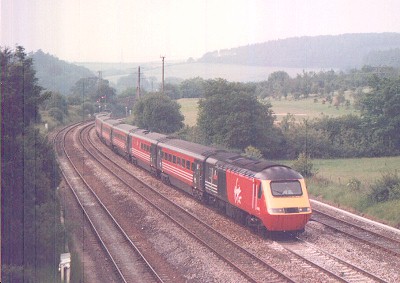
View from the A390 road bridge, looking north, in June 1997. The two loops are normally used to run-round china clay trains. The train is the southbound Glasgow to Penzance "Cornish Scot", in full Richard Branson livery, running late as usual. I'm not totally sure whether Richard Branson's garish livery suits HST sets; I'll leave you to make up your own mind!
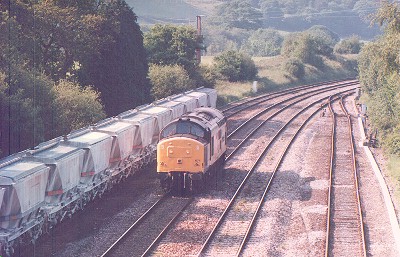
From the same location, Class 37 No 37674 runs round a rake of loaded china clay hoppers before heading down the branch to Carne Point. The clay probably originated from the huge clay dries at Goonbarrow, on the Newquay branch, and will be exported by sea from the docks at Fowey. The Class 37s have dominated the local freight workings in Cornwall for almost 20 years now; a fleet of nine of these 1960s-built locomotives are outbased to St Blazey shed for this work.
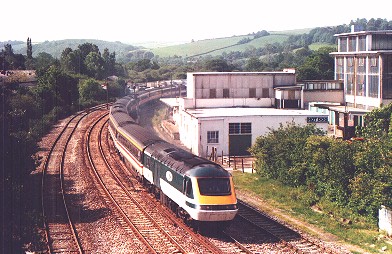
Looking the other way from the road bridge sees a Penzance-Paddington HST, the leading power car painted in the new post-privatisation livery, not matching the rest of the train as is typical for Great Western trains. The now disused siding that once served the creamery is on the right, almost invisible beneath the weeds. The milk traffic now clogs up the roads instead.... Such is 'progress'.
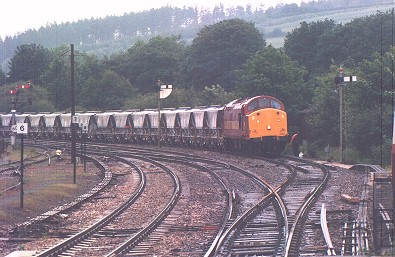
Looking north from the level crossing on a wet day in June 1997. Class 37 no 37521 sits in the down loop with a loaded china clay train from Marsh Mills, near Plymouth, waiting for another train to clear the branch from Carne Point. The locomotive was one of the first of St Blazey's allocation to be painted in the new red and gold EWS livery.

The same location on an equally wet day a year later. 37375 and 37797 head the southbound Cliffe Vale-St Blazey Clayliner. The spring 1998 timetable change makes it possible to photograph this working in Cornwall in daylight, and it also reverted to class 37 haulage rather than a single class 60. This pair of locos had been working this train all week. The clay wagons are empty on the southbound run, their load of china clay having been used to make toilet bowls (Thanks to Dave Harrison for that last piece of information).

Class 47 No 47522 "Doncaster Enterprise" leaves the down refuge siding with a short train of 'Dogfish' ballast hoppers in June 1996. This locomotive was 'borrowed' by St Blazey depot for crew training purposes and was used for local freight workings around this time. Although now a freight locomotive, it's still painted in the old Parcels sector livery.

Class 158 express sprinter No 158823 enters the station, passing the ex-GWR signalbox. Note the track machine stabled in the old cattle dock siding. Personally I think these are the most boring trains to be found on Britain's railway system. Give me a class 50 and 5 Mk1s any day.

Back in 1988, Class 50 No 50149 passes the station with a trip working of four Polybulk covered hoppers, initially for Tavistock Junction. The wagons would ultimately end up in Switzerland, travelling via the Dover to Dunkirk train ferry After some complex shunting moves, it picked up a rake of empty CDAs for Marsh Mills. This locomotive is now preserved on the West Somerset Railway.
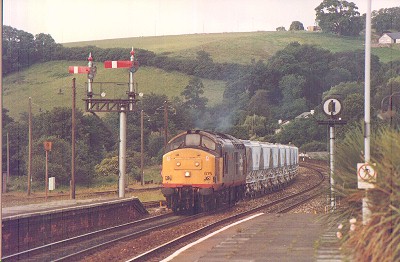
In June 1990, Class 37/5 No 37675, then named "William Cookworthy" comes off the Fowey branch with a train of empty CDA clay hoppers. It will run round in the down loop before heading back towards St Blazey. The locomotive was named after the Quaker apothecary that discovered china clay.
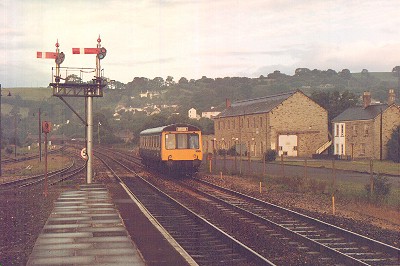
An early morning view looking south from the other side of the tracks. The old Cornwall Railway workshops, now used by various small businesses, are visible on the right-hand side. The single coach 'bubble car' is working empty from St Blazey to Liskeard, to work the Looe branch.

Class 60 No 60069 works the northbound Burngullow-Irvine "Silver Bullets" on a Saturday morning in June 1998. The distinctive tank wagons contain china clay slurry for use in the paper industry. The train gets it's nickname from the time it first stated running, when the stainless steel wagons were kept clean. During the summer of 1998 this was the only freight working not booked for class 37 haulage. No doubt it's a candidate for the new EMD-built class 66s in the near future.
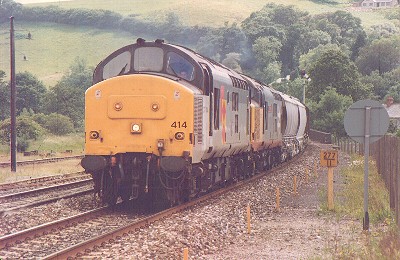
Class 37s 37414 and 37675 head the afternoon St Blazey-Gloucester Speedlink, consisting of just seven wagons. This train ceased to run after the end of the Speedlink wagonload network a year later, although much of the traffic survives, now carried by "Enterprise" trains.
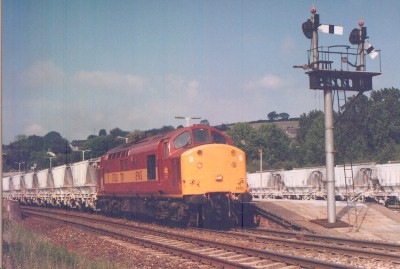
37521 again, preparing to head down the branch to Fowey with another train on loaded CDAs. Another train of empty CDAs sit in the sidings in the background.
| Home > Railways | Next> |